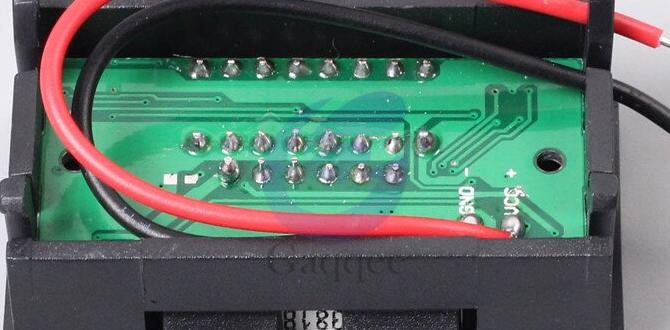Have you ever wondered how to keep your 12v lead acid battery healthy? Understanding the right charge voltage is key! A well-charged battery can last much longer and power your devices better.
Did you know that charging a lead acid battery isn’t just plug and play? It’s important to know the correct voltage. Too low, and your battery won’t charge fully. Too high, and it could get damaged. Nobody wants that!
Imagine you’re about to head out on a road trip. Your car won’t start because the battery is weak. What a bummer! But if you learn about charge voltage now, you can avoid that problem later. Let’s explore how to properly charge your 12v lead acid battery and keep it running strong.
Optimal Charge Voltage For 12V Lead Acid Battery Maintenance

Charge Voltage for 12V Lead Acid Battery
When charging a 12V lead acid battery, the correct voltage is crucial for optimal performance. Typically, a bulk charge requires about 14.4 to 14.7 volts. This helps fully recharge the battery. However, for float charge, a lower voltage of about 13.2 to 13.6 volts is ideal. Did you know that overcharging can shorten a battery’s life? Understanding these voltage ranges can save you time and money. Keep your battery healthy and remember to check the voltage regularly!Understanding Lead Acid Batteries
Definition and types of lead acid batteries. Key components and working principles of lead acid batteries.Lead acid batteries are used in many places like cars and backup power systems. They come in two main types: flooded and sealed. Each type has its own unique features. These batteries have key parts like the positive and negative plates and an electrolyte solution. They work by transforming chemical energy into electrical energy. This happens when the battery is charged and discharged, supplying power to devices. Understanding how they function helps us use and care for them better.
What are the key components of lead acid batteries?
- Positive Plates: Made of lead dioxide, they help create electricity.
- Negative Plates: Made of sponge lead, they store energy.
- Electrolyte: A sulfuric acid solution that helps the chemical reaction.
- Separator: Keeps the plates apart to prevent short-circuiting.
Importance of Charge Voltage
Explanation of charge voltage and its significance. Impact of charge voltage on battery life and performance.Charge voltage is like the magic potion that keeps a 12V lead acid battery alive and kicking. Think of it as the battery’s favorite snack! If the voltage is too low, the battery won’t get the energy it needs, which can lead to a sad, sluggish battery life. A proper charge voltage keeps the battery happy and ensures maximum performance. If you feed it the right voltage, you can prolong its life and make sure it performs like a champ!
| Charge Voltage (Volts) | Impact |
|---|---|
| 12.0 – 12.4 | Undercharged, shorter life. |
| 12.5 – 12.9 | Healthy charge, good performance! |
| 13.0 – 14.4 | Fully charged, ready to rock! |
Remember, keeping the charge voltage right is like giving your battery a nice cup of coffee. Too much or too little can lead to trouble, so keep it balanced!
Recommended Charge Voltage Levels
Standard charge voltage for a fully discharged 12V lead acid battery. Optimal float and absorption voltage ranges.For a 12V lead acid battery, the standard charge voltage is crucial. If the battery is fully discharged, it needs about 14.4 to 14.7 volts to charge properly. This ensures it fills up safely and efficiently. For regular use, the optimal float voltage is 13.2 to 13.5 volts. This keeps the battery charged without overloading it. Here’s a quick summary:
- Standard charge voltage: 14.4 to 14.7 volts
- Optimal float voltage: 13.2 to 13.5 volts
- Absorption voltage range: 14.4 to 14.7 volts
What is the optimal charge voltage for a 12V lead acid battery?
The optimal charge voltage for a 12V lead acid battery is between 14.4 to 14.7 volts. This voltage helps to restore the battery’s strength safely.
Factors Affecting Charge Voltage
Temperature influences on charge voltage. Age and condition of the battery.Many factors can change how much charge voltage a 12v lead acid battery needs. Temperature plays a big role. Hot weather can raise the voltage, while cold weather can lower it. Batteries also get older with time. An old battery may not hold a charge well. Its condition matters too. A battery with damage will need different voltage levels than a new one.
How does temperature affect battery charging?
High temperatures can increase charge voltage, but low temperatures decrease it.
Key Points:
- Hot weather: Higher voltage needed
- Cold weather: Lower voltage needed
- Old batteries: Less effective at holding charge
Keep these factors in mind. They help ensure your battery charges correctly. Always check your battery’s age and temperature for the best results.
Common Charging Mistakes to Avoid
Overcharging and its effects. Undercharging and potential risks.Charging a lead-acid battery is like cooking—too much heat can spoil the dish! Overcharging can puff up the battery like a balloon, causing leaks or even explosions. Yikes! Just imagine a battery party gone wrong! On the flip side, undercharging is like serving half-cooked pasta; it leads to poor performance and can damage the battery long-term. Always check your charger to keep your battery happy and healthy!
| Error | Effects |
|---|---|
| Overcharging | Can leak, swell, or explode! |
| Undercharging | Poor performance, shortens battery life. |
Monitoring and Maintaining Charge Voltage
Tools and equipment for measuring voltage. Regular maintenance tips for prolonged battery life.To keep your 12V lead-acid battery happy, you need some handy tools. A multimeter is your best friend for checking voltage. It’s easy to use and tells you if your battery is sad or just tired. Regular checks can help. Aim to measure the voltage at least once a month.
Also, tidy up the battery terminals and keep them free from dirt. Like we all need a good shower, batteries don’t like grime! Over time, this simple upkeep can add years to your battery’s life. So, let’s check that voltage and say hello to a healthy battery!
| Tool | Purpose |
|---|---|
| Multimeter | Measures voltage accurately |
| Wire Brush | Cleans battery terminals |
| Voltage Tester | Quick voltage checks |
Choosing the Right Charger
Types of chargers suited for 12V lead acid batteries. Features to look for in a battery charger.Picking a charger for your 12V lead acid battery is key! You need a charger that fits like a glove. Look for smart chargers that can adjust their power. They prevent overcharging, which is like giving your battery a gentle hug instead of a hard shove! Some chargers come with special features, like a display showing the charge level. Check this handy table below to compare different types:
| Charger Type | Features |
|---|---|
| Smart Charger | Adjustable settings, overcharge protection |
| Trickle Charger | Slow charging, ideal for long-term storage |
| Rapid Charger | Fast charging, great for emergencies |
Choose wisely, and your battery will thank you! Just think of it as picking the best snack for a movie night. Who wouldn’t want popcorn instead of broccoli?
Environmental Considerations
Disposal and recycling of lead acid batteries. Safety measures during charging and handling.Lead acid batteries can be harmful if not disposed of properly. Always recycle them at designated centers. This protects our environment. Handle these batteries with care. Use protective gear like gloves and goggles during charging. Follow these safety tips:
- Never charge a battery indoors without ventilation.
- Keep batteries away from fire and heat sources.
- Do not short-circuit the terminals.
With proper care and recycling, we can help keep our planet clean and safe.
What are the safety measures for charging lead acid batteries?
Always charge in a well-ventilated space. Use gloves and goggles to protect yourself. Keep away from flames and follow manufacturer instructions to ensure safety.
Conclusion
In summary, charging a 12V lead-acid battery requires careful attention to the voltage settings. You should aim for 14.4 to 14.8 volts for optimal charging. This ensures your battery stays healthy and lasts longer. Remember to check your connections and use a good charger. For more tips on battery care, consider exploring additional resources or guides. Happy charging!FAQs
Sure! Here Are Five Related Questions About Charging Voltage For A 1Lead-Acid Battery:To charge a 1 lead-acid battery, you need to use the right voltage. Usually, you should charge it at about 14.4 volts. This helps the battery fill up with power safely. If you use too high a voltage, it could be damaged. Always check the battery’s instructions for the best voltage.
Sure! Please go ahead and ask your question. I’m here to help!
What Is The Recommended Charging Voltage For A Standard 1Lead-Acid Battery During The Bulk Charging Phase?The recommended charging voltage for a standard lead-acid battery during the bulk charging phase is usually around 14.4 to 14.8 volts. This helps the battery store a lot of energy quickly. Remember, you should always check the battery’s instructions for specific details. Charging it correctly keeps it healthy!
How Does Temperature Affect The Charging Voltage Requirements For A 1Lead-Acid Battery?Temperature changes can affect how we charge a lead-acid battery. When it’s colder, the battery needs a higher voltage to charge properly. In warm weather, it can charge with less voltage. So, we have to adjust the voltage based on whether it’s hot or cold outside. This helps keep the battery safe and working well.
What Are The Implications Of Overcharging A 1Lead-Acid Battery, And How Can The Charging Voltage Be Adjusted To Prevent This?Overcharging a lead-acid battery can be bad. It can make the battery get too hot, leak, or even break. This means the battery won’t work well or for long. To avoid this, you can lower the charging voltage. You can use a charger that matches the battery’s needs and check it often.
How Does The Charging Voltage Differ Between Flooded, Sealed (Agm), And Gel-Type 1Lead-Acid Batteries?When charging, flooded lead-acid batteries need about 2.4 to 2.5 volts per cell. Sealed batteries, like AGM (Absorbent Glass Mat), need around 2.3 volts per cell. Gel-type batteries require about 2.2 to 2.3 volts per cell. So, each type of battery needs a different amount of voltage to charge properly. It’s important to use the right voltage to keep the batteries safe and working well.
What Methods Can Be Used To Accurately Measure The Charging Voltage Of A 1Lead-Acid Battery During The Charging Process?To measure the charging voltage of a lead-acid battery, you can use a multimeter. First, set the multimeter to measure voltage. Then, connect the red probe to the battery’s positive terminal and the black probe to the negative terminal. This will show you the voltage while the battery is charging. You can also use a battery charger with a built-in display to see the voltage easily.







